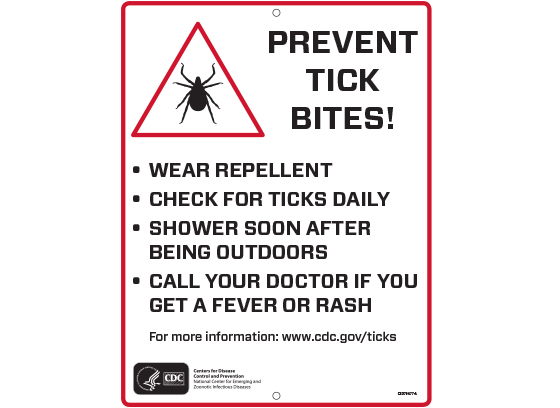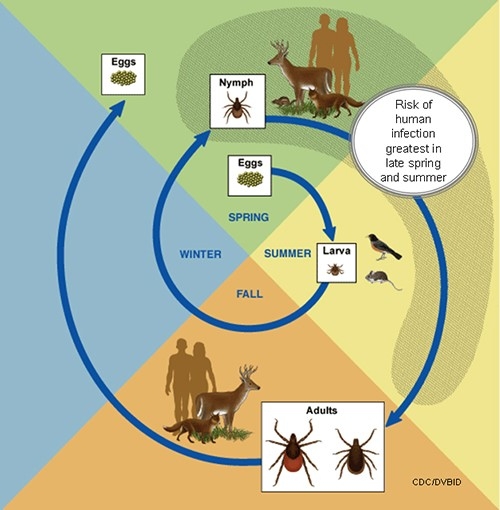Tick-borne Diseases
Tick-borne diseases are transmitted through the bite of an infected tick. Ticks can be infected with bacteria, viruses, or parasites. Lyme disease is the most common tick-borne disease in Maryland. Other tick-borne diseases include Rockey Mountain Spotted Fever, Babesiosis, Ehrlichiosis and Tularemia.
If you believe you have a tick-borne illness, please contact your healthcare provider. Howard County Healthcare Providers who need to submit a reportable illness case to the Health Department should call 410-313-1412. Providers may also email infectiousdisease@howardcountymd.gov for assistance.

Lyme Disease
What is Lyme Disease?
Lyme Disease is a bacteria transmitted to humans by the bite of an infected blacklegged tick (or deer tick). If not treated, the infection can spread to joints, heart and nervous system.
Resources:
What are the signs and symptoms of Lyme Disease?
Early signs and symptoms that usually occur within 3–30 days after a tick bite might include:
- Fever, chills, fatigue, muscle and joint aches, and swollen lymph nodes
- Bulls-eye (Erythema migrans) rash
- Occurs in approximately 70-80% of infected people.
- Begins at the site of the tick bite.
- Can expand over time to 12" or more.
- May feel warm, but is rarely itchy or painful.
How is Lyme Disease diagnosed and treated?
Lyme disease diagnosis is based on signs and symptoms and history of possible exposure. You and your health care professional will decide how to proceed after discussing these circumstances. Should treatment be necessary, those receiving antibiotics in the early stages of Lyme disease usually recover quickly and completely.
Rocky Mountain Spotted Fever
What is Rocky Mountain Spotted Fever?
Rocky Mountain spotted fever (RMSF) is an infection caused by the bite of an infected tick. It affects over 2,000 people a year in the U.S. and usually occurs from April until September. But, it can occur anytime during the year where the weather is warm. It was first recognized in the Rocky Mountain states, but may occur throughout the U.S. The most common areas affected are in the southeastern and south central U.S. The disease is spread to humans through a bite from an infected tick. It is not spread from person to person.
What are the symptoms of RMSF?
-
Signs and symptoms begin 3–12 days after a tick bite.
-
Illness begins with sudden onset of fever and headache.
-
Rash typically occurs 2–4 days after the onset of fever. It is highly variable, and some people may fail to develop a rash.
-
Other symptoms include nausea/vomiting, abdominal pain, body aches, and swelling around the eyes and on the back of hands.
-
RMSF is a rapidly progressive disease and without early administration of treatment, it can be fatal within days.
If you believe you have been infected with RMSF, contact a medical provider immediately.
How to prevent Rocky Mountain Spotted Fever?
Protect yourself from ticks:
-
Wear long pants, long sleeves, and close-toed shoes. Tuck pants into socks. Tuck shirts into pants.
-
Wear clothing/shoes treated with the tick repellent permethrin. It kills ticks on contact with the clothing.
-
Avoid sitting on logs, stumps, or the ground in brushy areas. Periodically inspect clothing and your body before ticks become attached. Use a lint roller brush to remove ticks from clothing.
-
Use insect repellents (such as DEET) according to label directions. Put sunscreen on first, then repellent. Never use DEET underclothing or on pets.
-
Shower when possible after being outdoors.
-
Throw clothes in a hot dryer for 10 minutes before washing, to kill any lingering ticks that may be attached to clothing.
Resources:
Preventing Tick Bites
The best defense against Lyme disease and other tick-related infections is to reduce expose to ticks. The CDC recommends the following:
- Avoid wooded and brushy areas with high grass
- Walk in the center of trails
- Repel Ticks with DEET or Permethrin DEET
- Use repellents that contain 20 to 30% DEET (which also protects against mosquito bites) on exposed skin and clothing. Protection may last up to several hours. Parents should apply repellent on children (avoid hands, face and eyes).
- Use products that contain 0.5% Permethrin to treat clothing, gear (boots, socks, pants) and tents. It will remain protected through several washings. Pre-treated clothing is available at many camping/outdoor stores and may provide longer protection
- Wear light colored clothing to help spot ticks more easily
- Wear long pants and sleeves and tuck your pants into your socks or boots
Conduct Ticks Checks on People, Pets and Gear
- Take a shower or bath as soon as possible after coming indoors to wash off and find the ticks that may be crawling on you.
- Do a full-body tick check using a hand-held or full-length mirror to view all parts of your body after coming in from a tick-infested area.
- Check: underarms, in and around ears, inside the belly button, behind the knees, between the legs, around the waist and especially in the hair!
- Parents: check children in the above areas too!
- Examine gear and pets. Ticks can get a free ride home on these items and attach themselves to humans later. Examine everything!
- Put clothes in the dryer on HIGH heat for 10 minutes to kill and possible ticks that you may have missed.
If you do find a tick attached to you, don't panic.

How to remove a tick
- Use tweezers to grab the tick as close to the skin as possible.
- Pull upward with steady, even pressure. Don't twist or jerk the tick, it can cause parts of the tick to break off and remain in the skin. (If it does remove what you can with tweezers, leave the remaining bits alone and let the skin heal.
- After removing the tick, thoroughly clean the bite area and your hands with alcohol or soap and water.
- Dispose of the tick by submersing it in alcohol, placing it in a sealed bag, wrapping it tightly in tape or flushing it down the toilet. Never crush a tick with your fingers.
- Hint: DON'T put nail polish, petroleum jelly or put a match to the tick to detach it from the skin!